Badminton game rules are the agreed set of principles upon which all players perform their best in order to win the matches. In our Badminton Basics article, we already covered the most important rules. In our Badminton measurements article, we also mentioned some important rules that focus on measurements such as court measurement, shuttle measurement, or racket measurement. Moreover, in our Badminton match article, we explained some rules that are at the core of a match. Finally, in our Badminton officials article, we explained the different roles of the officials in badminton.
In this article, we are bringing all that together, concentrating on the rules that will help you as a player to play according to the standards set by the Badminton World Federation. Our aim with this article is to provide a comprehensive and easy-to-understand explanation for the key badminton rules that guide the development of matches and tournaments.
Do you want to improve your badminton game? Then be sure to sign up for Badminton Famly+ by clicking here. Founded by former World Champion Thomas Laybourn, Badminton Famly+ is the best online training platform for badminton.
We have divided this article in several parts that follow the logic applied by the World Badminton Federation:
- Court & court equipment
- Shuttle and testing a shuttle for speed
- Toss
- Scoring system
- Change of ends
- Service
- Faults
- Lets
- Intervals and delay of play
- Officials
Court & court equipment rules
Court information
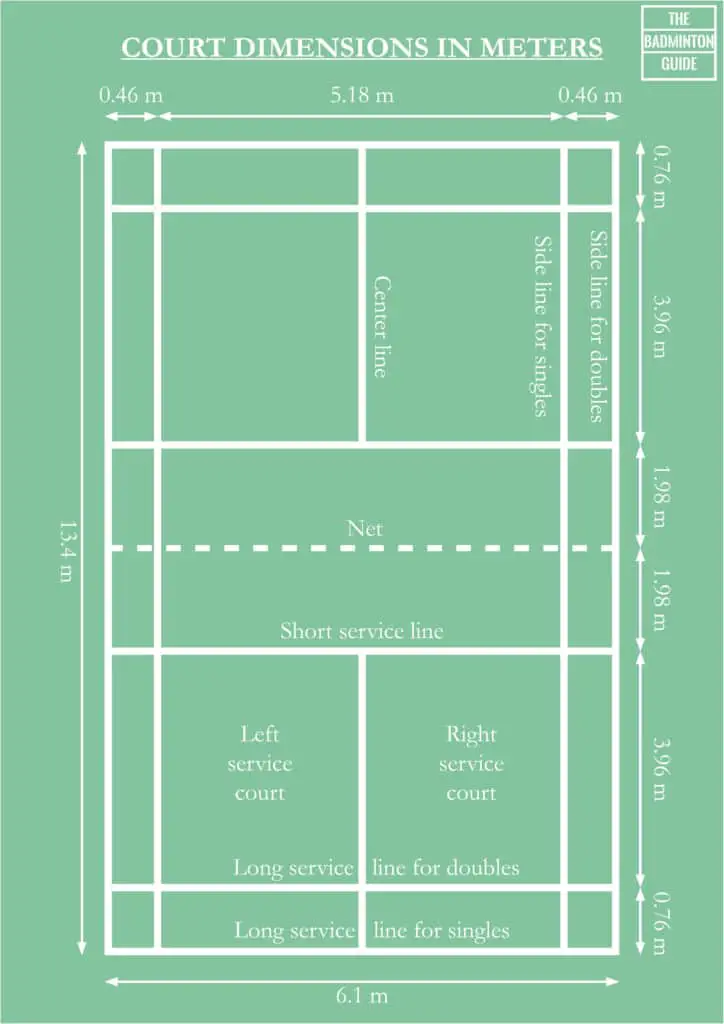
The badminton court is rectangular and it is divided by a net into two equal rectangles. The standard setting for a court is to be marked for both singles and doubles matches. The doubles court is wider than the singles one, but both are the same length. The only exception to that statement is that the doubles court has a different back serve line, which is shorter than the singles one. This often causes confusion for new players.
The lines marking the court are 40mm (1.6 inches) wide (and preferably white or yellow in color). When using badminton mats, the correct mounting of them will ensure that these measurements are correct. These lines are part of the area which they define, so both in the image above and in the data below the lines are included in the measurements.
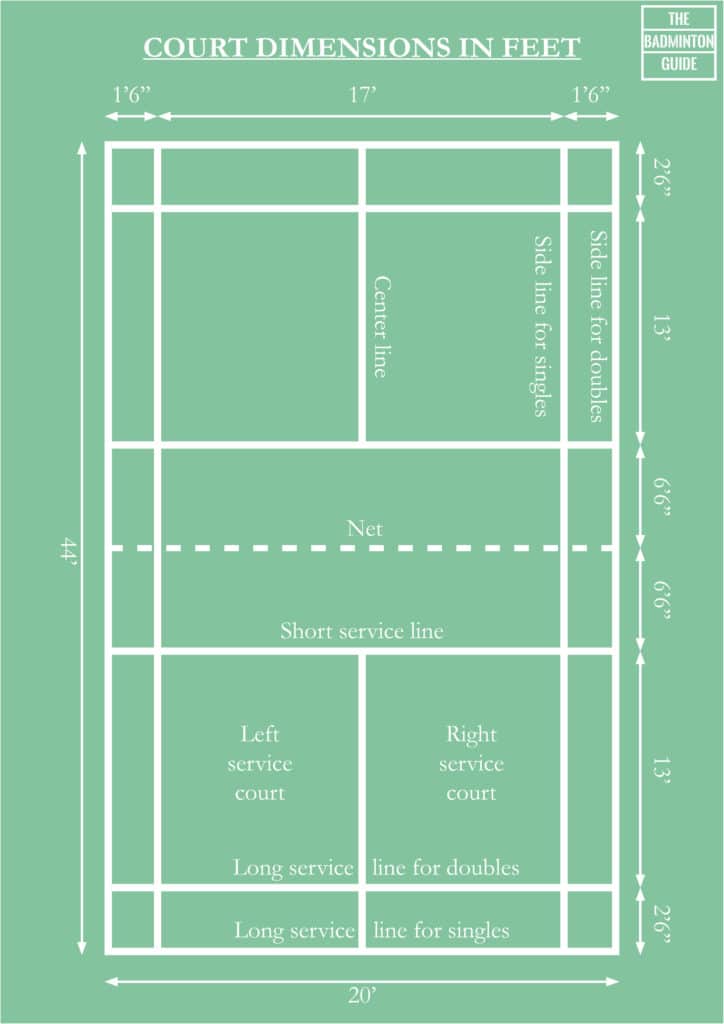
Court rules for singles matches
As you can see from the picture above, when a singles match is being played, the following measures are to be followed:
- Total width: 5.18 m (17 ft)
- Total length: 13.4 m (44 ft)
- This length is divided into two equal parts, 6.7 m (22 ft) each
- Front service line distance to the net: 1.98 m (6 ft 6 inch)
Court rules for double matches
As you can see from the picture above, when a doubles match is being played, the following measures are to be followed:
- Total width: 6.1 m (20 ft)
- Total length: 13.4 m (44 ft)
- This length is divided into two equal parts, 6.7 m (22 ft) each
- Front service line distance to the net: 1.98 m (6 ft 6 inch)
- Rear service line distance to the back: 0.76 m (2 ft 6 inch)
Court equipment information rules
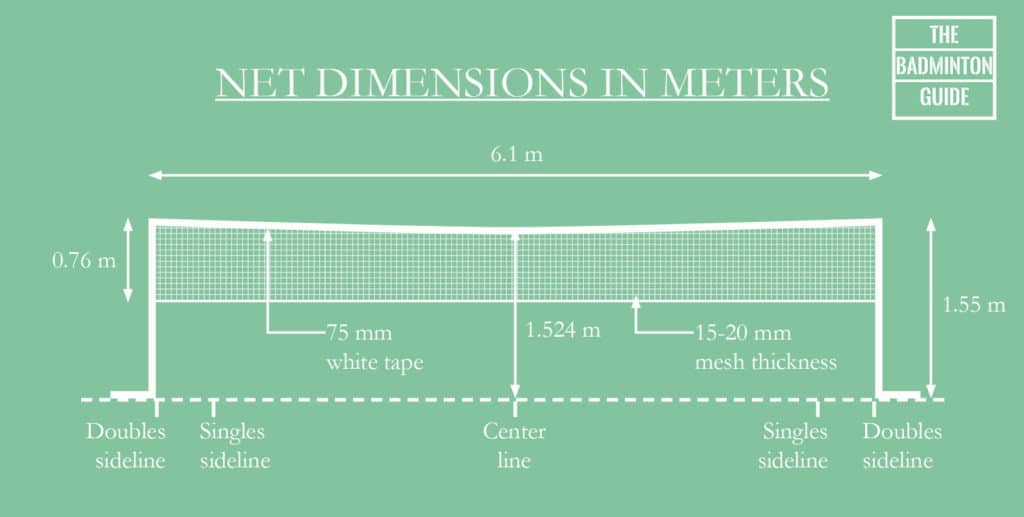
In addition to the court itself, it is also important to highlight the rules for the court equipment. The court equipment is made up of the posts and the net.
Post rules
The posts have to be 1.55 m (5ft 1 inch) in height from the surface of the court. Moreover, when the net is fully stretched in the dimensions we will see below or on the picture above, the posts have to remain vertical. In addition to that, the posts must be placed on the double sidelines irrespective of whether singles or doubles is being played. You can see that in the picture above. Finally, the posts or their supports shall not extend into the court beyond the sidelines.
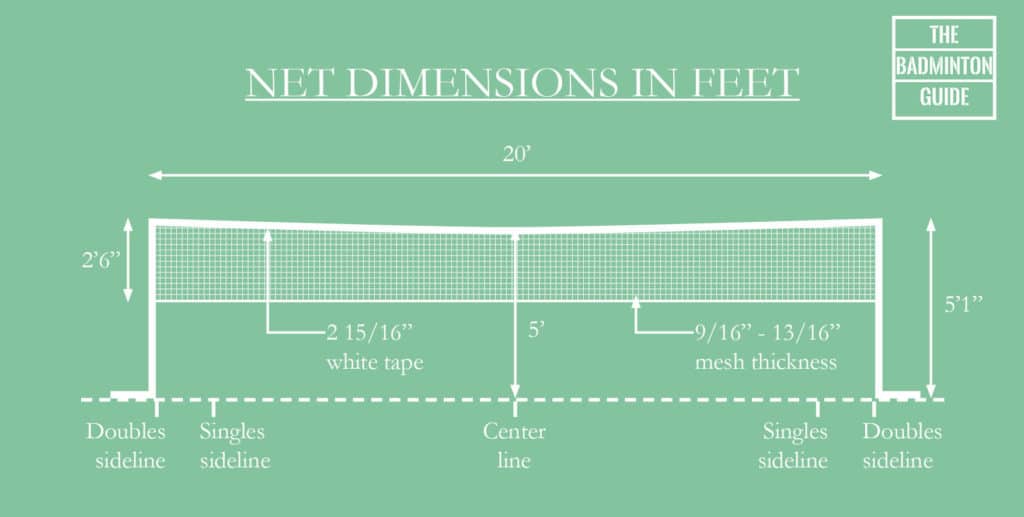
Net rules
Regarding the net, the Badminton World Federation is also very specific about it. The net has to be made of fine cord of dark color and even thickness, with a mesh of not less than 15 mm and not more than 20 mm. The net shall be 760 mm (2 ft 6 inch) in depth and 6.1 m (20 ft) wide (like the doubles court). The top of the net shall be edged with white tape, which has to be doubled over a cord or cable running through the tape. This tape shall be white and shall rest upon the cord or the cable. Moreover, the cord or cable shall be stretched firmly, flush with the top of the posts.
The top of the net from the surface of the court shall be 1.525 (5 ft) meters at the center of the court and 1.55 m (5ft 1 inch) over the side lines for doubles. There shall be no gaps between the ends of the net and the posts. If necessary, the full depth of the net at the ends shall be tied to the posts.
Shuttle and testing a shuttle for speed rules
Shuttlecock rules
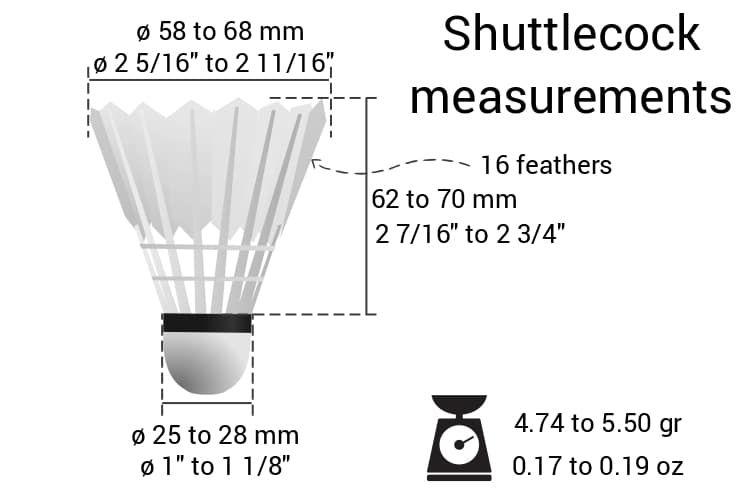
The shuttle shall be made of natural and/or synthetic materials. From whatever material the shuttle is made, the flight characteristics generally shall be similar to those produced by a natural feathered shuttle with a cork base covered by a thin layer of leather. When in a tournament, it is advisable to use one of the BWF’s preferred suppliers as a brand.
Feathered Shuttle
The shuttle shall have 16 feathers fixed in the base. The feathers shall have a uniform length between 62 mm (2.5
Non-Feathered Shuttl e
The skirt, or simulation of feathers in synthetic materials, shall replace natural feathers. The base shall be as described in the previous section. Measurements and weight shall be also as described in the previous section. However, because of the difference in the specific gravity and other properties of synthetic materials in comparison with feathers, a variation of up to 10 percent shall be acceptable. Subject to there being no variation in the general design, speed and flight of the shuttle, modifications in the above specifications may be made with the approval of the Member Association concerned, in places where atmospheric conditions due to either altitude or climate make the standard shuttle unsuitable.
Testing a shuttle for speed rules
Shuttle speed is a very interesting part of the rules. If you are new to the game and you have gone to one or two tournaments, you might have been surprised by seeing people testing the shuttles before the match. What is that about? The reason is that, according to the badminton games rules, the shuttle needs to have a specific speed. Therefore, the shuttle is tested to make sure this speed is correct.
To test a shuttle, a player shall use a full underhand stroke which makes contact with the shuttle over the back boundary line. The shuttle shall be hit at an upward angle and in a direction parallel to the sidelines.
A shuttle of correct speed will land not less than 530 mm and not more than 990 mm short of the other back boundary line.
If the shuttle goes further than that, the players are allowed to tweak the feathers in order to slow down the speed.
Toss rules
Before a match can start, it needs to be decided who is going to start serving.
In an official tournament, the umpire will toss a coin as it is done in most sports. Whoever has chosen the winning side can choose either to serve or receive. The other side will then exercise the remaining choice.
In more unofficial environments or during training, the shuttle is usually used. You throw the shuttle up and, when it lands, whichever side the cork of the shuttle is pointing towards, is the side that decides if it wants to serve or not.
Alternatively, the shuttle can be placed feathers down onto the net and let it fall from there. As with throwing the shuttle up, when the shuttle lands from the net, whichever side the cork of the shuttle is pointing towards, is the side that decides if it wants to serve or not.
Scoring system rules
A badminton match consists of the best of 3 games of 21 points. That means that the first player or team to win 2 games wins the match.
Every time a rally is played, there is a point scored. Obviously, the side winning the rally is the one that adds a point to its score. In addition to winning the point, the winning side will be the one serving in the next rally.
When the game ties at 20-20, the side which first gains a 2 point lead (that could be 22-20, 25-34, 27-25, etc.) will be the side that wins the game. If the match reaches 29-29, the side scoring the 30th point wins the game.
In addition to winning the game, the winning side will also start serving first in the following game (if there is one).
Change of ends rules
Change of ends simply means that the teams or individuals need to change sides of the court as it is customary in most sports. This is to ensure that, if there is a little advantage in one of the sides, that advantage is lost by both sides being able to play there.
The change of ends occurs always at the end of the first game. At the end of the second game, if the match goes to a third game, a change of end will also occur. While playing the third game and in order to keep equality, a change of ends will also occur in the middle of the third game, when the first of both sides reaches point number 11.
If the ends are not changed in any of these moments and the error is later discovered while still in play, the players should change ends the first time that the shuttle is not in play after having discovered the mistake.
Service rules
Service is probably the most difficult part of these rules. There are certain items that are shared for both singles and doubles and we will get into those first. After that, we will get into the specifics for each category, which gets especially complicated for doubles.
Serving diagonally
The most basic point for both types of matches is that you always serve diagonally as happens in other racket sports like tennis. So, if you are serving from the right side of the court, you will serve to the right side of the court of your opponent, thus diagonally.
You cannot stop a service movement once it has started
If you start with your backward movement in order to serve, any delay at the start of the service can be considered an undue delay. If that was the case, the umpire or service judge can call a fault and you can lose the rally.
In the video below you can see how this is indicated.
Both feet of the server and the receiver have to be in contact with the court and stay within the margins while serving
Moreover, some part of both feet of the server and the receiver have to remain in contact with the surface of the court in a stationary position from the start of the service until the service is delivered.
It is also mandatory that the part of the feet in contact with the court does not touch the lines that mark your position, be it the front line or the sideline. This is true for both the server and the receiver.
In the video below, you can see how the judge called fault when the foot is moved while serving.
The server’s racket shall initially hit the base of the shuttle
When serving, it is also mandatory to hit the base of the shuttle first. The base of the shuttle is the cork, the semispherical part that is always the one that flies towards you when in play.
In the video below you can see the fault called when the first part of the shuttlecock that is hit is not the base.
All the shuttle has to be below waist height when hitting the shuttle
In order to perform the service correctly, it is mandatory that the shuttle is below waist height when it is being hit in the service movement.
The waist is considered to be an imaginary line around the body, at the same height as the lowest part of the server’s bottom rib.
In the video below, you can see how the fault is called when the player hits the shuttlecock above the waistline.
The racket head and the shaft have to be pointing down while serving
In addition to the shuttle being below waist height, another important element is that the racket head and shaft have to be pointing down while serving.
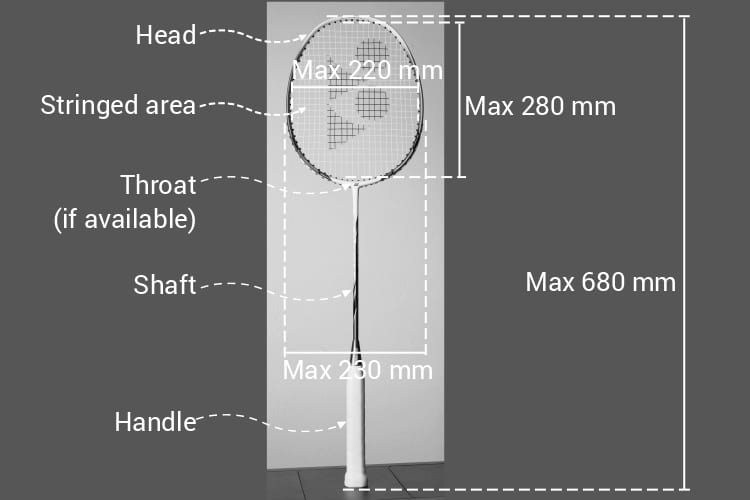
In the following video, you can see how the fault is called when the racket was not pointing down.
Serving in singles
In singles, the player who starts serving with 0-0 as a score will start serving from the right side of the court. This is because, whenever the server’s score is even, the server will serve from the right side. On the other hand, whenever the server’s score is odd, the server will serve from the left side of the court.
For example, if the server wins the rally that is being played, he or she will score one point and serve from the other side of the court. If the score was 0-0 and the server wins, he will simply move to the left side of the court and serve from there.
However, if it is the receiver that wins the rally, he will (obviously) score a point and will become the server. The new server will serve from whichever side the score indicates. If the receiver has scored its first point, for example, being an odd number, he/she will serve the following point from the left side. On the other hand, if the receiver has, for example, scored its 6th point, being it an even number, he/she will serve the following point from the right side.
Serving in doubles
Serving in doubles is a bit more complicated than in singles. However, we will try to explain it in its most simple form.
The two most basic rules are the following:
First, each side has only one service. This means that, if you start serving and you lose the point, the service “passes” to the other team.
Second, players do not change their respective service courts until they win a point when their side is serving.
These two rules being clear, we can see how this unfolds.
As it happens in singles, you have to serve from whichever side your score indicates. If, for example, your team is serving and its current score is 14, then your team has to serve from the right side. Who has to serve, though? Well, it depends. If you are serving and you win the rally, you keep the service and move onto the other side of the court. If the opponents are serving and you win the rally, you get the service and however was on the right side of the court on the previous rally will serve.
Example
What does that mean? What it means is that if you serve with the 0-0 and the other team wins the rally, then the service goes to them and they will serve from the left side as they are winning 1-0. Who will serve? The player that was already on the left side when you served in the 0-0.
However, if you serve with the 0-0 and you win the rally, then you will move to the left side of the court and serve again from there, whereas the other team will stay in the same position that it was before. This way, you will serve to the other player of the opposite team.
Faults rules
After the long service section, this gets a bit easier. If you have made it past the service without breaking the rules, there are the following items that will be considered a fault while in the middle of a rally.
The shots are not alternated between sides
This rule will be obvious to experienced players but might not be so obvious to new players. In a rally, the shuttle must be hit by both teams alternately. What does that mean? It means that your team cannot hit the shuttle twice in a row, as that becomes a fault and the point is therefore lost. The same obviously stands for singles.
The receiving partner hits the shuttle after the service
As we said in the service section, the service is always performed diagonally and the person staying in the diagonal side from the server is the receiver. If for whatever reason, while playing doubles, the partner of the receiver returns the service instead of the receiver, that will be considered a fault and the point will go to the serving team.
The shuttle lands outside the boundaries of the court, the shuttle doesn’t pass over the net or hits the ceiling or walls
Whenever the shuttle lands outside the boundaries of the court, it will be considered a fault and therefore the point will go to the opponent. Moreover, if the shuttle doesn’t pass over the net, it will also be considered a fault. In addition to that, if the shuttle hits the ceiling or walls of the sports hall, that will be considered a fault and the rally will go to the opponent person or team.
The shuttle touches the person or the dress of a player or touches any other object or person outside of the court
If you are playing and your opponent manages to hit you with the shuttle, it will be considered as your fault and the point will go to him or her. Whenever the shuttle touches any other object or person outside of the court, the fault is from the person that has hit the shuttle and therefore the point goes to the opponent.
The player touches the net or its supports with racket, body or dress
Another cause of a fault is whenever a player touches the net or its supports with racket, body or dress. In this case, the fault is called instantly and the point goes to the opponent.
The player invades the opponent’s court in the following circumstances
Whenever a player invades the opponent’s court, it is usually a bad sign, although not always.
For example, a fault will be called if the player invades the opponent’s court over the net with racket or body unless it is simply following the shuttle over the net with the racket in the course of a stroke. This is acceptable as long as the initial point of contact with the shuttle is on the striker’s side of the net.
If the racket or person invades the opponent’s court under the net such that an opponent is obstructed or distracted, that will also be considered a fault.
You are also not allowed to obstruct an opponent, for example preventing him or her from making a legal stroke where the shuttle is followed over the net.
Last but not least, players are not allowed to deliberately distract an opponent by any action such as shouting or making gestures.
Lets rules
Let is called by the umpire (or by a player if there is no umpire) to stop a rally. When a “let” occurs, the play will be resumed without taking into account the current rally and the player who served after the last finished rally shall serve again without any change in the score.
The following reasons can make an action worthy of being called “let”.
- If the server serves before the receiver is ready. This is true as long as the receiver doesn’t move. If the receiver moves and tries to get the shuttle, it will be considered that he was ready.
- During service, both the receiver and the server are deemed to have committed a fault.
- The shuttle is caught on the net and remains suspended on its top.
- After having passed over the net, the shuttle is caught in the net.
- The shuttle disintegrates during play with the base completely separating from the rest of the shuttle.
- Play is disrupted (for example because a shuttle from a different court lands in the court) or a player of the opposing side is distracted by a coach.
- A line judge is unsighted and the umpire is unable to make a decision.
Intervals and delay of play rules
The match has to be continuous from the beginning of the match until the end, with only the intervals as moments where the players can recover.
Intervals
In each game, when the side that is leading reaches 11 points, the players have an interval of 60 seconds, where usually the coaches join the players to give instructions.
In addition to the interval at point 11, players also have a 2-minute interval at the end of each game.
Delay of play
Any item that falls out of the intervals can be considered a delay of play. In badminton, it is not allowed to delay the play in order for the players to recover strength or wind or to receive advice. Players are supposed to get ready for the next point straight after the previous point is finished.
However, the umpire is the sole judge of what is considered a delay of play and, sometimes, the umpire will leave a bit of room to the players, especially after a very demanding rally.
Officials
The badminton officials are divided into different roles or positions:
- Referee
- Umpire
- Service judge
- Line judge
Referee
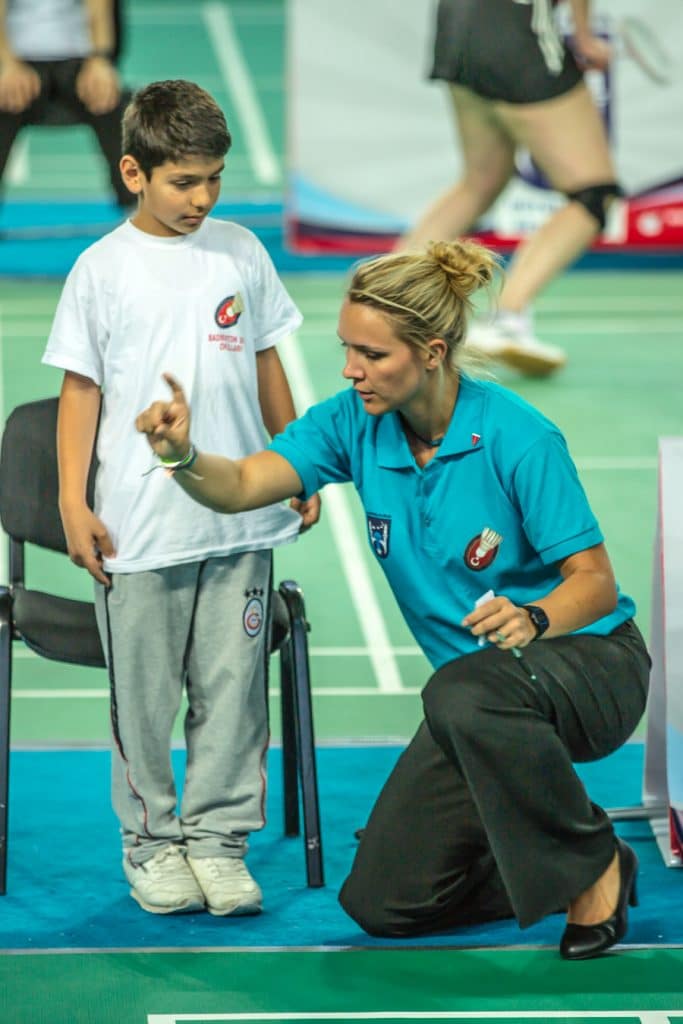
The referee is the most important official of the whole tournament. He is in charge of the competition and needs to ensure that the tournament is conducted following the Laws of Badminton (including court, rackets and shuttlecock measurements), the regulations of the Badminton World Federation and/or any other regulations that might be relevant in that specific competition.
In addition to that, the referee has the last word if there is an argument between the umpire (in charge of the matches) and a player or team.
Moreover, the referee makes sure that the facilities and the conditions to play are up to the standards required for that specific tournament. For example, he has to check that the badminton mats are mounted correctly so they can enhance gameplay.
Finally, the referee is also in charge of the approval of the schedule of matches and practice (if applicable).
Umpire
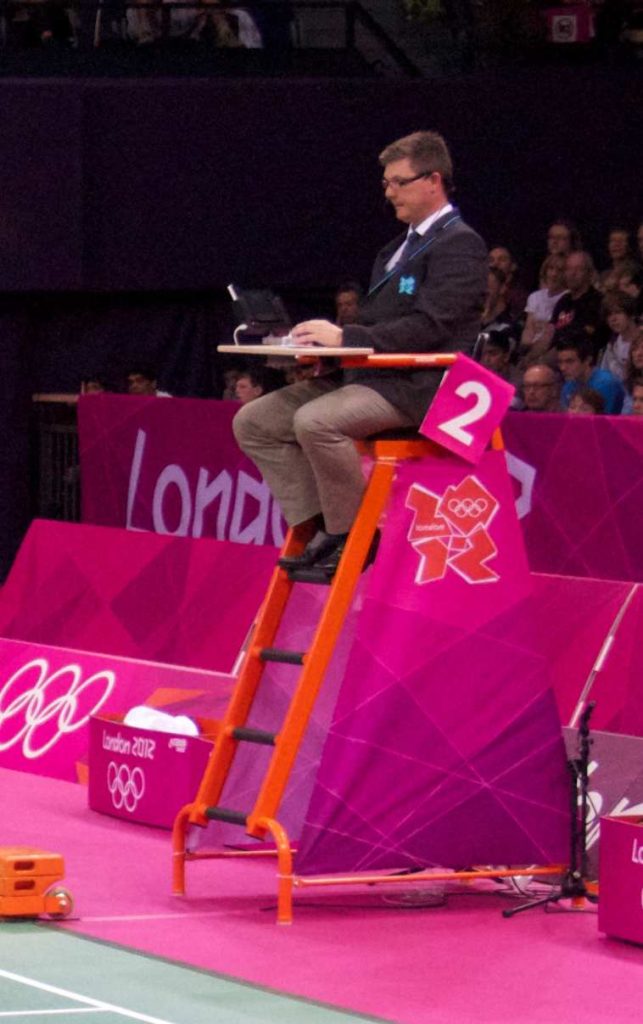
The umpire is the maximum authority in a particular match and it is in charge of the court. The duty of the umpire is to make sure that the specific match is conducted following the Laws of Badminton, the regulations of the Badminton World Federation and/or any other regulations that might be relevant in that specific competition.
It is the umpire responsibility to judge service faults and other player faults. The umpire keeps a record of any misbehavior or incident and reports it to the referee. He/she is also responsible for keeping the match score, which will be announced after each point of the match.
The umpire has control over the specific match but also needs to report any serious acts to the referee, who is, in the end, the maximum authority of the tournament.
Outside of the major tournaments, the referee will also take the role of an umpire in order to help with the process.
Service Judge
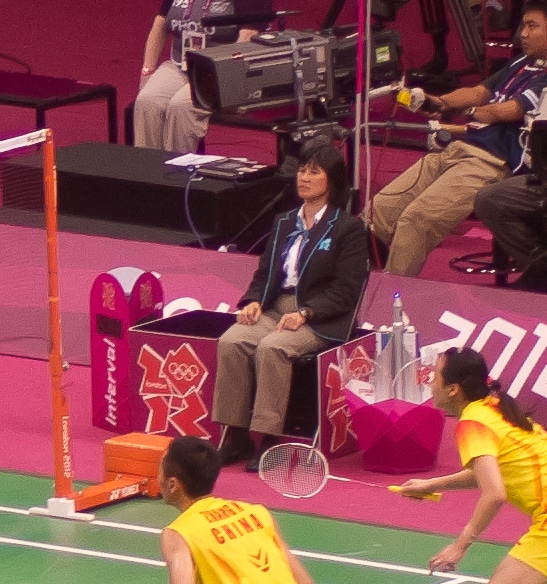
The service judge is responsible for making a ‘service fault’ call and to provide shuttles to the players. Due to the way badminton is played, the
In smaller championships, when there is no service judge, the umpire takes the role of the service judge.
Line Judges
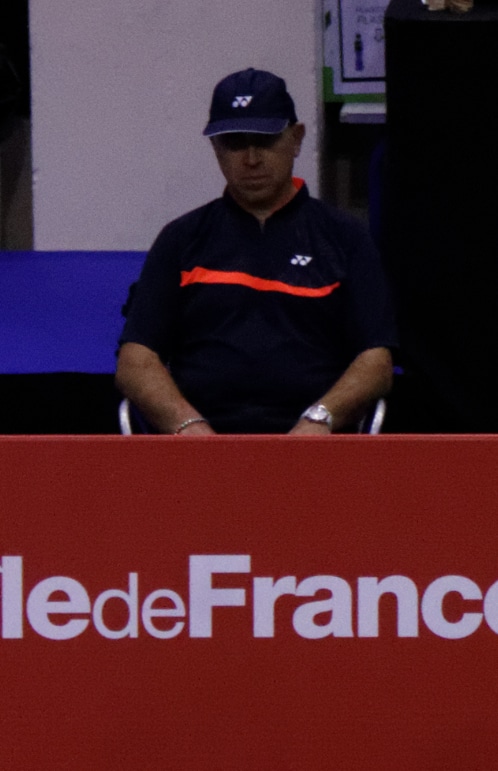
The line judges are responsible for indicating whether a shuttlecock landed “in” or “out” if the shuttle lands near the lines he/she is assigned to control. Due to the fast speed of the game and the skill of the players, this is a very challenging job and, as a result, the line judges are the officials that usually get more pressure from the players.
In recent years, an Instant Review System has been implemented, that helps ensure that the right decision is taken, but which also adds pressure to the line judges as it clearly shows when a mistake has taken place. Each player has two incorrect calls per game of the match.
Final words
And with the officials, we have reached the end of our badminton game rules article.
Have we missed any rules that you think are very important in order to understand the game? Is there any rule that you did not understand fully? Then let us know in the comments below!
This article is based on the Laws of Badminton and the Simplified Rules of Badminton, both documents from the Badminton World Federation.

